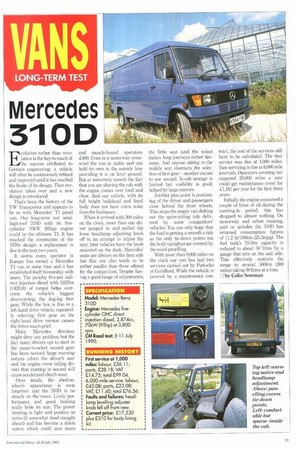Mercedes 310D
Page 21

If you've noticed an error in this article please click here to report it so we can fix it.
F4 volution rather than revolution is the key to much of the success attributed to German engineering: a vehicle will often be continuously refined and improved until it has reached the limits of its design. Then revolution takes over and a new design is introduced.
That's been the history of the VW Transporter and appears to be so with Mercedes' Ti panel van. Our long-term test semihigh-roof 3101) with its fivecylinder 70kW (95hp) engine could be the ultimate Tl. It has reached the constraints of the 1970s design: a replacement is due in the next two years.
It seems every operator in Europe has owned a Mercedes Ti van at some time and it has established itself favourably with users. The punchy five-pot indirect injection diesel with 192Nm (1421bft) of torque helps overcome the vehicle's biggest shortcoming; the dog-leg first gear. While the box is fine in a left-hand drive vehicle, repeatedly selecting first gear on the right-hand drive version causes the driver much grief.
Many Mercedes devotees might deny any problem, but the fact many drivers opt to start in the easier-to-select second gear has been noticed: large warning notices adorn the driver's seat and the engine cover telling drivers that starting in second will cause accelerated clutch wear.
Once inside, the shed-onwheels appearance is soon forgotten and the 310D is no slouch on the move. Lively performance and good braking really belie its size. The power steering is light and positive on turns (if somewhat dead straight ahead) and has become a delete option which could save mean
and muscle-bound operators £400. Even in a motorway crosswind the van is stable and can hold its own in the outside lane providing it is on level ground. But at motorway speeds the fact that you are sharing the cab with the engine comes over loud and clear. And our vehicle, with its full height bulkhead and lined body does not have extra noise from the loadspace.
When it arrived with 300 miles on the clock, more than one driver jumped in and pulled the loose headlamp adjusting knob off in an attempt to adjust the seat; later vehicles have the knob mounted on the dash. Mercedes' seats are always on the firm side but this one also tends to be rather smaller than those offered by the competition. Despite having a good range of adjustments, the little seat (and the noise) makes long journeys rather tiresome, And anyone sitting in the middle seat obstructs the selection of first gear—another excuse to use second. In-cab storage is limited but visibility is good, helped by large mirrors.
Another plus point is positioning of the driver and passengers close behind the front wheels. This stops the empty van dishing out the spine-jolting ride delivered by some competitors' vehicles. You can only hope that the load is getting a smooth a ride as the only tie-down points (on the body uprights) are covered by the wood panelling.
With more than 9,000 miles on the clock our van has had two services carried out by Puttocks of Guildford. While the vehicle is covered by a maintenance con tract, the cost of the services still have to be calculated. The first service was clue at 1,000 miles: then servicing is due at 6,000 mile intervals. Operators covering our expected 20,000 miles a year could get maintenance cover for £1181 per year for the first three years.
Initially the engine consumed a couple of litres of oil during the running-in period; this has dropped to almost nothing. On motorway and urban running, part or unladen the 3101) has returned consumption figures of 11.2 lit/100km (25.3mpg). The fuel tank's 70-litre capacity is reduced to about 50 litres by a gauge that errs on the safe side. This effectively restricts the range to around 500km (300 miles) taking 50 litres at a time.
7 by Colin Sowman
































































































